Menu
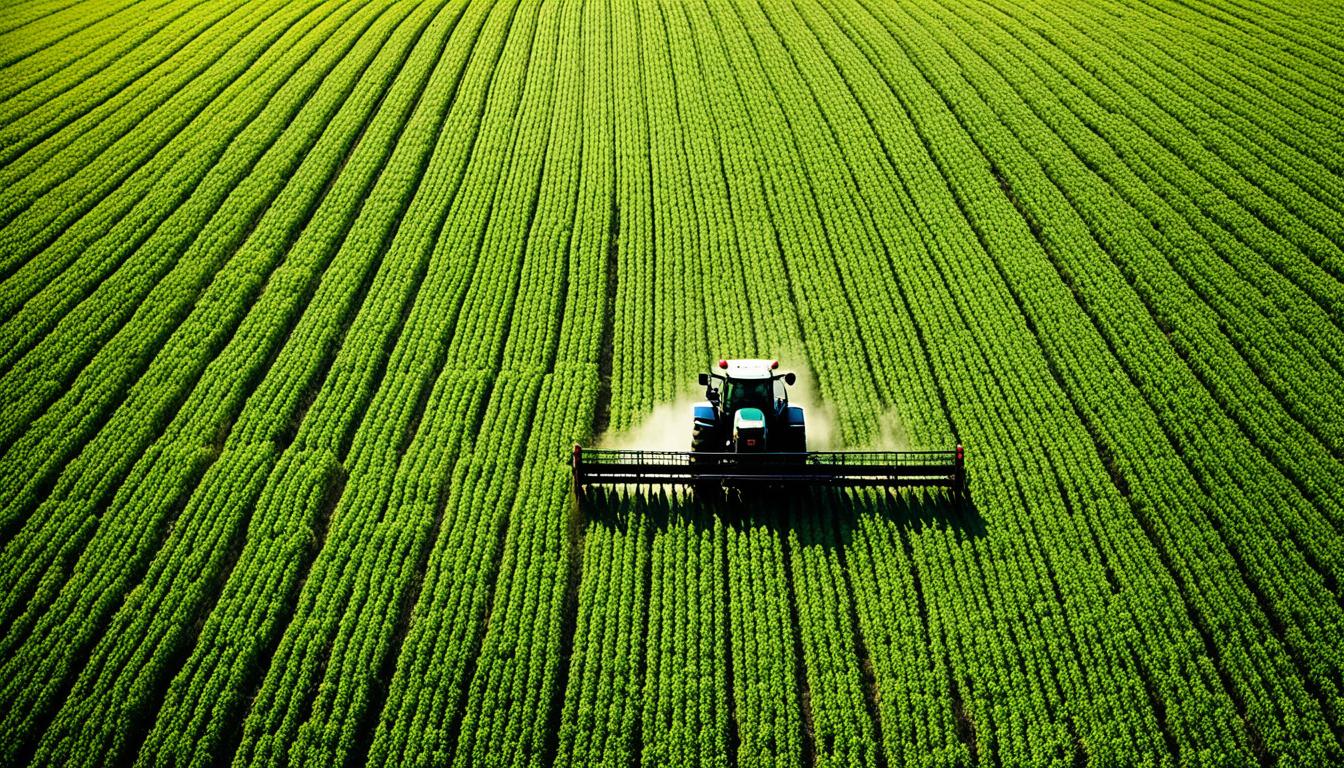
Did you know that last year, natural disasters cost American farmers over $21 billion in crop losses? This high figure highlights the need for strong agricultural policies and support. The *Inflation Reduction Act of 2022* has provided a massive $18 billion for conservation efforts. These funds are crucial for farms to overcome challenges due to climate change.
The problem is, this amount falls short of what’s needed. More than double the amount of funds are required. The US Farm Bill’s reauthorisation is currently under debate. Its aim is to tackle the shortage of funds and ensure a stable future for farming, despite the challenges of climate change.
The US agricultural policy framework is key in shaping the rural scene and ensuring we all have enough to eat. It takes a wide view, helping in areas like preserving nature, growing rural areas, and supporting farmers. This strong system ensures our farmers and countryside thrive.
Today, US agriculture is guided by the 2018 Farm Act. This law, covering everything from crop insurance to helping rural areas, replaced the 2014 Farm Bill. It can change many different laws, showing its wide reach. What’s more, for transparency, the ERS puts out a yearly report on US agricultural policies.
The importance of these policies is huge. They offer crucial help to the farm sector through well-structured plans, focusing on long-term health and economic strength. For instance, many farmers are part of conservation programs throughout the country. This shows how these initiatives support sustainable changes and boost rural places.
These policies are also about finding a balance. They make sure farming supports our economy and our environment. By offering help, farmers can grow their businesses in a way that’s friendly to the planet. So, these policies look at the big picture. They cover everything from how food is grown to keeping the countryside beautiful, guiding our nation’s farm rules.
The 2024 Farm Bill reauthorisation matters a lot to those in farming and those watching agricultural policies. It looks to meet the needs of farmers and the country’s farming goals.

The Farm Bill update has big effects on farming. President Biden wants to up the Department of Agriculture’s funds by 7.4% in 2025. But, a bill from the House set to reduce funds by 30% for 2024 shows a difference in opinions.
The Senate’s bill for 2024 plans to spend $500 million more than the prior year, mostly on nutritional support for women, children, and infants. This shows how it’s tough to agree on where funds should go in farm policy.
The 2018 Farm Bill got extended to September 2024, giving more time to work on a new bill. This extension helps keep things steady for now. But, it also shows the need to sort out a clear and updated farming policy soon.
The House and Senate shared their 2024 Farm Bill outlines. The House wants to beef up help for farmers and put more money into protecting nature. They’re reacting to the growing challenges from climate change.
The Senate aims to boost nutrition help and promote making products from plants. It also introduces new plant insurance ideas. The Senate’s funding plans got full support in their committee, showing lots of agreement there.
Even though they share some goals, the House and Senate have different focuses in their bills. This means there’s a lot to figure out as they try to agree. Their debates are key to making farm policies that help farmers and meet wider goals for the environment and health.
Getting the 2024 Farm Bill agreed on is crucial for America’s farms. Keeping up with these policy updates is vital to see how the farm sector will move forward.
Conservation programmes are vital in US agriculture, focusing on eco-friendly practices. They get a lot of money from recent laws. This cash helps with soil, water, and fighting climate change. But, some talks might cut this money, which worries people about the future impact.
The Inflation Reduction Act gives $19.5 billion to the Department of Agriculture for smart climate projects. This big amount shows a serious effort to cut greenhouse gases and save carbon. Important projects like the Regional Conservation Partnership and others get help. This backing is key for good environmental farming.
The farm bill’s future spending is under debate. It might allocate just $13 billion for important conservation work. The debate shows how critical it is to carefully plan and secure these funds for the necessary agriculture conservation programmes.
US farming relies on various conservation efforts. These include smart ways for animals to graze, less pesticide use, and controlled fires. They all get a boost from the Inflation Reduction Act, helping agriculture stand up to a changing climate.
Important programmes, like the Conservation Reserve Program, are looking to expand. They want to raise the land limit by two million acres by 2029. Adding more grasslands is part of aiming for better conservation. Other schemes, such as EQIP and CSP, now require plans to cut farm emissions. They focus on trapping more carbon. This approach aims for all-round progress in environmental farming.
Fighting for strong conservation is crucial despite funding worries. It not only helps our land but makes sure farming can sustain in the long run.
The Inflation Reduction Act (IRA) of 2022 is a big step for farming, especially in terms of saving the environment. Worth about $770 billion, it has about $40 billion for farming, forestry, and improving the countryside. This big cash shows strong help for farmers and land managers as they deal with climate change.

Almost $20 billion in the IRA goes to green farming projects. This includes things like making farms more eco-friendly, keeping them safe, and fixing up the land. These projects get way more money now than in the past, nine times more, thanks to this act.
There’s also $5 billion for looking after the forests better and another $3 billion for clean energy in the countryside.
Farmers like the push for more eco-friendly and weather-proof farms. They’re happy with the $18 billion going into farming and forests that work smart against climate change. But, there’s a debate in Congress about keeping this money coming in the long run.
Some projects in the past few years didn’t fully match up to being eco-smart. Yet, there are teams working on making sure the next steps will be better.
Folks want to make sure the IRA’s help doesn’t stop in 2031. They hope to get a plan started in the 2023 farm bill to keep these good projects going. This strategy is all about keeping steady, strong help for making farms and forests better for everyone.
“The Inflation Reduction Act represents an unprecedented opportunity for agriculture,” notes USDA Secretary Tom Vilsack. “We must strategically allocate these resources to uphold our commitment to climate-smart practices and long-term agricultural sustainability.”
Extreme weather is a big problem for farming. It endangers our food and the earth’s future. In just one year, the U.S. lost over $21 billion due to crops failing. This shows how important it is to manage risks well in farming. Let’s look at the dangers and how we can fight them to keep farming alive.
Bad weather hits farming hard. It doesn’t just ruin crops. It causes floods, droughts, and storms that make food harder to find and more expensive. For example, in Nigeria, farmers face increasing costs due to bad weather. A farmer there saw a big drop in the amount of maize and rice they could grow because it cost too much. This happened in 2023.
By 2023, 3.1 billion people couldn’t buy healthy food. That’s 42% of the world not eating right. Plus, 735 million were hungry, 122 million more than before the pandemic.
The U.S. has plans to fight these risks, like using better farming methods. They’re also working on stronger farms and roads. In Nigeria, they’re also trying to limit the bad effects of the weather changes on farming.
The Nigerian Meteorological Agency warns there could be even more hunger soon. They say over 25 million people might starve in the lean season. So, farmers are changing what they grow to save money and keep growing food. These efforts together are meant to make farming more stable, even with the bad weather.
| Impact | 2023 Statistics |
|---|---|
| Global Food Insecurity | 735 Million People |
| Unaffordable Healthy Diet | 42% of World Population |
| Nigerian Inflation Rate | 29.9% (Food: 35.4%) |
| Affected Nigerian Farmers | Over 25 Million |
| Reduced Crop Yield in Nigeria | Maize, Rice, Cowpeas |
Looking deeper into sustainable farming, the role of soil health and saving water is vital. U.S. farming policy heavily supports these methods with big funding. This shows their importance for future farm productivity and taking care of our planet.
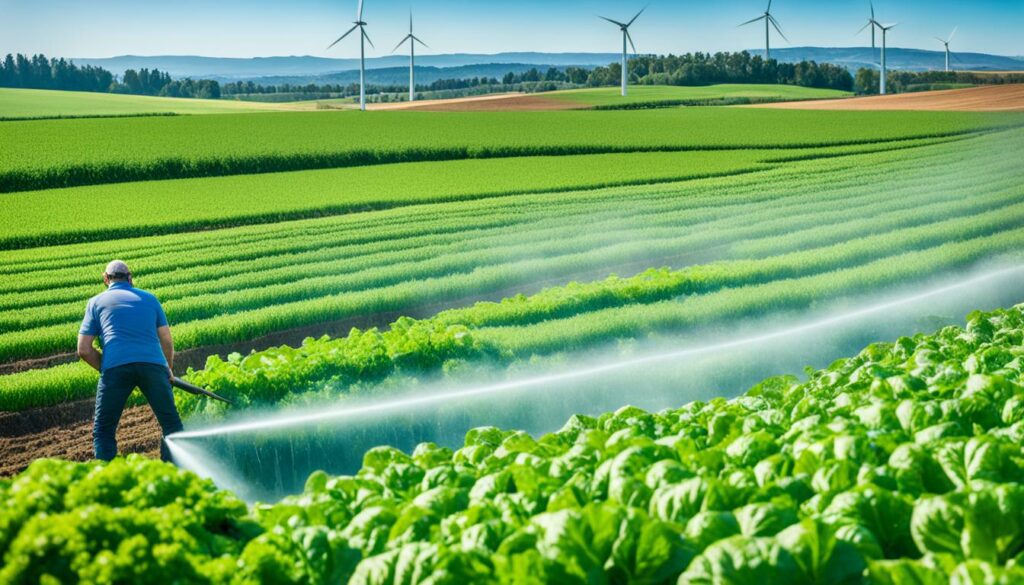
Soil health is key in sustainable farming. Good soil helps keep water, nutrients, and supports high crop growth. The SARE program, with over $46 million in funding from the USDA, is deeply committed. It helps farmers use smart ways to grow their crops, no matter the region.
Conserving water in farming is now essential. The SARE program actively helps with water-saving projects. This means farms are better prepared for climate changes. Techniques like smart irrigation, special crop types, and collecting rainwater help farming to stay strong.
Here’s a table showing the impact of SARE’s work:
| Year | Investment (million $) | Projects Funded | Focus Areas |
|---|---|---|---|
| 2022 | 2.2* | Various | Agricultural research, education, and Extension |
| 1988-2023 | 380 | 8,400+ | Climate-smart solutions, soil health, water conservation |
This table shows the huge effort made in sustainable farming. Companies like Clover Sonoma and Starbucks play a big role too. They focus on cutting down methane and making all farming more sustainable.
To sum up, working on soil health and saving water is crucial for farming’s future. With ongoing support and investment, we can make farming better for the planet and for the people who work the land.
Recent updates in farming have shown big changes in laws. This means rules must keep up with new conditions. The Midwest’s quick start to planting in April shows how important it is for farms to be up-to-date.
The U.S. wants to check beef for bird flu in places with sick dairy cows. This shows how serious it is to watch out for animal sickness. Also, President Biden is pushing for green jet fuel made from corn. It’s a move to use more eco-friendly energy. AGree has been working for ten years to make farming better for nature and farms. This shows how government policy is working to make farming stronger.
The new May report on farming is a big deal. It tells us about the new year’s farming and market needs. This helps everyone plan better. The fight against animal sickness is getting more money. This includes $200 million to fight bird flu and help dairy farmers who lose out.
AGree wants the next Farm Bill to help farmers with good advice, ways to reduce risks, and money. This means encouraging farmers to protect the environment and make their farms stronger.
| Key Focus Areas | Details |
|---|---|
| Animal Disease Surveillance | Testing beef for avian influenza, $200M allocated for bird flu mitigation |
| Sustainable Energy Guidance | Green jet fuel production for corn ethanol producers |
| Supply and Demand Estimates | First look at new crop year’s balance |
To sum up, the latest updates in farming show a fast-moving sector. It’s marked by careful changes in laws and updates to farming policies. These are all aimed at keeping farming healthy and productive.
The proposed 2024 Farm Bill by the House and Senate Committees plans to boost the farmers’ safety net. It aims to keep farmer incomes stable, even with changing markets and weather.
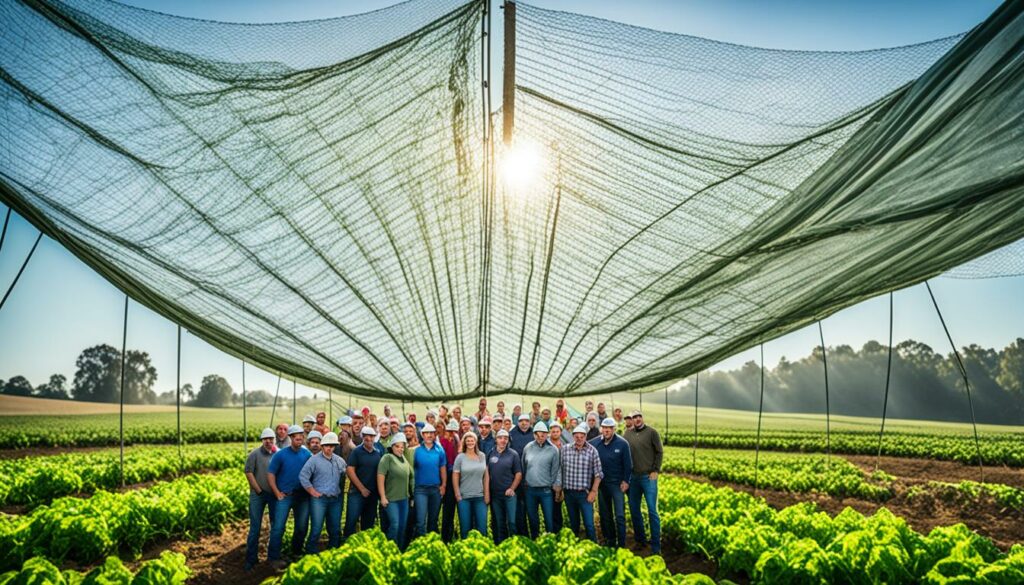
The safety net’s key parts are the PLC and ARC plans. These help farmers deal with money troubles due to low prices or crop risks. The Senate also wants to use IRA funds for better conservation. This could raise crop prices and make these plans work better.
Fruits, vegetables, and nuts are key to US farming. The Senate plan adds a section just for these crops to help manage risks. This change means these crops will get more help than before.
The House wants to move $14.4 billion to better conservation and help specialty crops. These moves show a strong wish for a fair, strong farm world. As talks go on, it’s important to watch how these ideas are carried out. We must make sure all farms get good support.
The farmer’s world is always changing, and we see the need for good subsidy mechanisms in agriculture. These systems help keep farmers afloat and encourage eco-friendly farming. They make sure farmers can keep up with their work and stay successful.
The U.S. Department of Agriculture (USDA) is putting $1.5 billion into the Regional Conservation Partnership Program (RCPP) for 2024. This is part of President Biden’s efforts to support the environment. Over the next five years, more than 180,000 farms on 225 million acres will benefit. Also, the Inflation Reduction Act’s $19.5 billion includes $4.95 billion for the RCPP in the same period.
Currently, the Natural Resources Conservation Service (NRCS) is using $1.8 billion on 256 RCPP projects in almost every state. Tribal projects got a $100 million boost. This shows how important subsidies are in keeping farming sustainable.
The role of agricultural subsidies in the coming policies is under the spotlight. The House Agriculture Committee is working on a new farm bill. This bill would increase spending on crop subsidies by $23 billion but cut SNAP funding by $28 billion over ten years. Crops like cotton, rice, and peanuts may see their subsidies go up by 140%.
This increase plans to put $17.4 billion more into the Price Loss Coverage (PLC) programme. It would also expand the Agriculture Risk Coverage (ARC) system. The aim is to make the subsidy processes quicker. The NRCS wants to cut down the time it takes to make agreements from 15 months to 6 months. They are also improving policies and tools for business and giving more power to State Conservationists.
Government efforts to improve nutritional help show how much they care for those in need. They aim to make sure vulnerable groups can find enough food. A big change is happening with the Thrifty Food Plan, key for SNAP, to make food assistance better.

Recent Thrifty Food Plan updates are about making better food a real choice for everyone. The US Department of Agriculture considers current health guidelines, food costs, and what people eat. It tries to show the true expense of a healthy diet. This would help families pick healthier foods.
Changes in food support go beyond just the Thrifty Food Plan. The USDA is working to make its food help match changing times and real needs. These efforts are part of the Farm Bill’s food aid, with most funds going to these efforts. With these changes, better support is made for people, especially 12 million kids, struggling with hunger.
The U.S. Department of Agriculture (USDA) is making big investments in clean energy. They are supporting biofuels and jobs, aiming to lower energy costs. This shows the government’s strong support for the agricultural sector.
The USDA is putting in a lot of money for biofuels. They’ve given out $238 million for projects through two big programs. These efforts are especially helping renewable energy in farms across America.
The Higher Blends Infrastructure Incentive Program has added $43 million to make domestic biofuels more available. Now, in June 2023, another $450 million is set to further boost biofuels. This shows a long-term commitment to using biofuels in farming.
Biofuels are really helping in farming. Ethanol has cut fuel costs by 25%, and in many states, gas is under $2.99. The USDA has also invested a lot to make sure more places have biofuels at their gas stations, with a big focus on Iowa.
Big boosts are happening in biofuels sales. For example, Casey’s is increasing their supply by 50 million gallons. And Piasa Enterprises Inc. expects to sell 2 million more gallons of biodiesel yearly. AC&T Inc. is also installing more ethanol equipment in Maryland to increase sales by over 106,000 gallons a year.
| Programme | Funding | Impact |
|---|---|---|
| REAP | $238 million | Support across 35 states and Puerto Rico |
| HBIIP | $43 million | Increase biofuels availability in 15 states |
| Casey’s Initiative | $5 million | 50 million gallons/year increase in biofuels supply |
| Piasa Enterprises Inc. | $200,000 | 2 million gallons/year increase in biodiesel sales |
| AC&T Inc. | – | 106,000 gallons/year increase in ethanol supply |
The USDA’s strong support for biofuels highlights their importance in agriculture. These initiatives are key for a sustainable farming future.
Trade and export policies in agriculture are key for U.S. farm products to be known worldwide. The U.S leads in exporting agricultural goods globally. The USDA closely watches trade and export policies in agriculture to understand their impact. They work to make sure U.S. farmers can compete well worldwide.
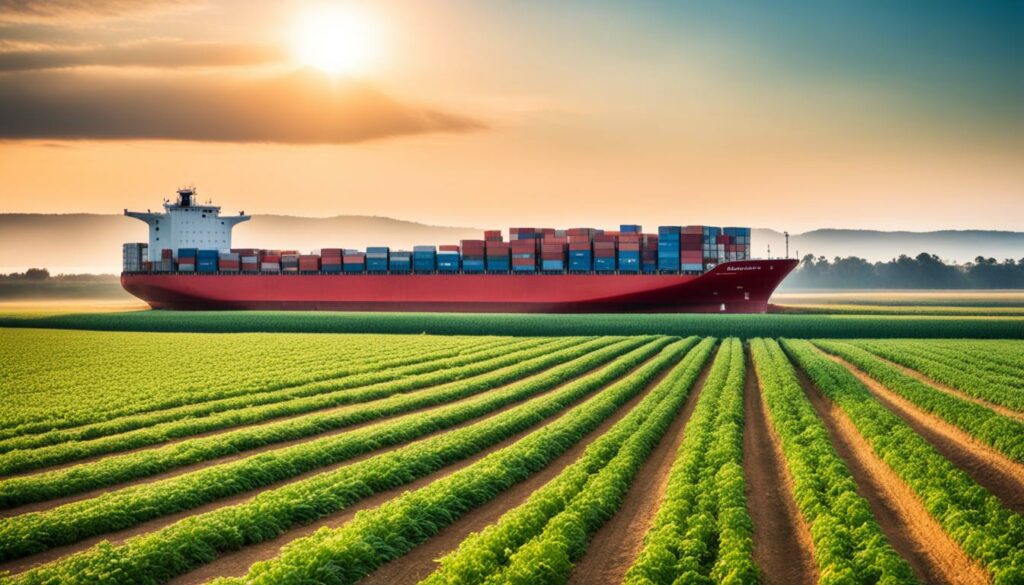
The U.S. promotes open trading to help boost agriculture in poorer nations. The USDA, together with groups like the Foreign Agricultural Service and the Office of the U.S. Trade Representative, focuses on making good trade deals. This effort aims to open up international markets for U.S. farmers.
Market Access Programmes greatly help in reaching more agricultural markets. They push U.S. farm products in foreign lands, breaking down barriers to trade. The Indo-Pacific Economic Framework is a big effort towards this. It aims to make a top-notch deal that will help U.S. farming.
Developing foreign markets is key to expanding U.S. agriculture globally. The pact with Kenya started in July 2022 to boost trade and economic growth. There’s also the U.S.-Taiwan 21st Century Trade Initiative, showing efforts to find new thriving sectors. The Americas Partnership for Economic Prosperity helps boost economic ties with other countries for mutual growth.
In 2023, U.S. agricultural exports totalled $181 billion. This high number shows the impact of trade and export policies in agriculture. These policies improve the U.S. economy and keep the U.S. farming sector strong in the global market.
Rural development policies and agricultural productivity are closely linked. These policies focus on investing in infrastructure and services. This helps not only farmers but also improves life for those in rural areas.
Recognising the need for infrastructure investment in rural areas, policies set aside big sums for projects. For example, the European Agricultural Fund allots €95.5 billion for 2021-27. Part of this, €8.1 billion, addresses COVID-19 through the EU recovery fund.
This money goes towards important areas like loans, microcredit, and more. The aim is to support the most crucial projects. Moreover, the LEADER Programme oversees local projects to drive innovation and sustainable growth. The Smart Villages Initiative, on the other hand, pushes for technological progress in rural spots.
At least 35% of the budget goes to projects focusing on climate, biodiversity, and animal welfare. This ensures the developed infrastructure meets environmental goals.
Rural policies also focus on healthcare and education. The USDA is introducing new efforts to strengthen these in rural regions. For healthcare, there are partnerships to improve water systems. For education, grants are available to boost educational access.
This support aims to make rural spots vibrant and healthy. Policies are designed to enhance the lives of people living in the countryside. This isn’t just about farming, it’s about the overall well-being of rural communities.
| Investment Area | Description | Allocated Funds |
|---|---|---|
| Infrastructure | Loans, microcredit, guarantees, and equities for priority projects | €95.5 billion (total EAFRD budget 2021-27) |
| LEADER Programme | Management of thousands of local projects | At least 5% of RDP funding |
| Smart Villages Initiative | Innovation in rural areas | Covered under EAFRD and national CAP strategic plans |
| Climate & Biodiversity | Environmental and animal welfare measures | At least 35% of rural development funding |
| Healthcare | Access to clean water, modern wastewater systems, technical assistance for rural hospitals | Variable under new USDA initiatives |
| Education | Grant funding, housing loan feedback, enhanced access | Variable under new USDA initiatives |
Investments are key for building a bright future in rural areas. They aim to support both farming and the general well-being of rural folks.
US agricultural policy is shaped by global events. This offers insights into international trade and market stability. *Global supply chain impacts* and conflicts affect US farming significantly. This shows how US policy is linked to worldwide issues.
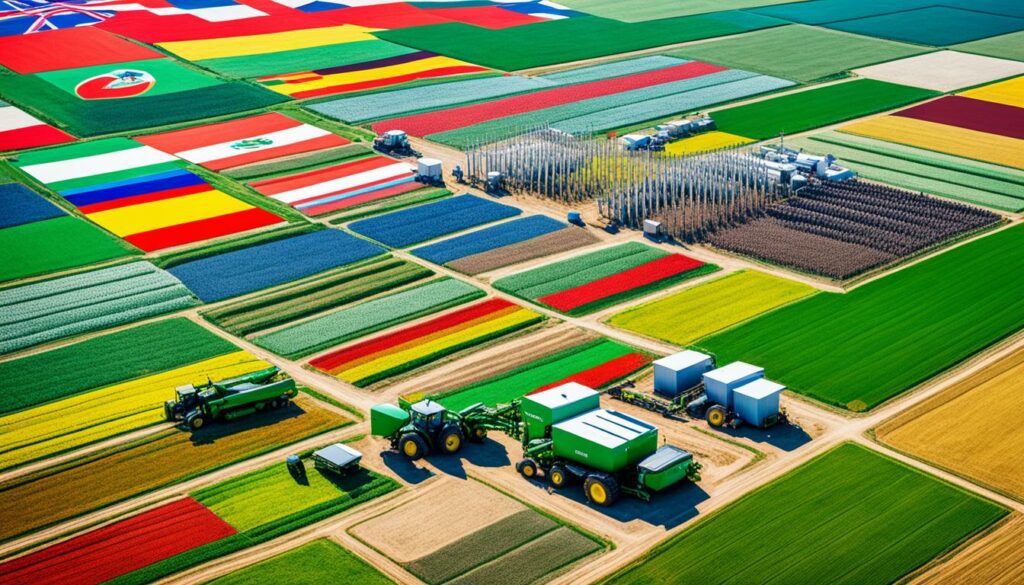
Conflicts around the world can deeply affect agricultural supplies and prices. In 2023, US trade wins allowed access to markets valued at $6.4 billion. Yet, ongoing instability can disrupt these gains, affecting the global flow of goods.
Inflation plays a key role in supply chain problems. In 2023, the USDA launched the Regional Agricultural Promotion Program (RAPP) to help. It was a $1.2 billion effort to support struggling markets. *International perspectives on US agri policy* stress the importance of strong supply chains. The FAS’s 25 trade shows in 15 countries resulted in $1.5 billion in expected sales. This effort shows why stable supply chains are vital.
| Event | Outcome |
|---|---|
| Total U.S. agricultural exports in 2023 | $174.9 billion |
| Trade wins in 2023 | Access to markets worth $6.4 billion |
| FAS’s trade missions | 1,600+ meetings, $70 million in projected sales |
| FAS’s international trade shows | $1.5 billion in projected sales |
| USDA’s RAPP initiative | $1.2 billion investment |
| FAS’s Food for Progress and McGovern-Dole Programmes | $442 million investment |
Understanding the agricultural world means looking at economic factors. The economic influence on agriculture goes beyond simple market prices. It includes things like the Consumer Price Index (CPI), interest rates, and costs of building. All these things affect the economy of farms, guiding choices and results in the farming industry.
The Consumer Price Index (CPI) shows how prices are changing over time. It reflects what consumers pay for goods and services, showing the inflation rate. Changes in inflation affect farming by changing the prices of inputs and the products farmers sell. So, when CPI changes, it affects how much money farmers can make.
Interest rates are key in the economic influence on agriculture. When interest rates are low, farmers can borrow money cheaply to invest in their farms. This helps them grow and become more efficient. However, when rates rise, it’s harder for them to borrow what they need, which can slow down their growth.
At the same time, building and labour costs are high. This makes it tough for farmers to improve their buildings or grow their operations. The high costs of building can stop them from investing, affecting how well they can compete and how productive they are.
| Factor | Impact on Agriculture |
|---|---|
| Consumer Price Index | Influences cost of inputs and pricing of commodities |
| Interest Rates | Affects loan affordability and investment capabilities |
| Construction Costs | High costs limit infrastructure expansion and upgrades |
The US agriculture industry is facing crucial changes. The 2024 Farm Bill proposals from the House and Senate aim to help farmers and the environment. President Biden wants to raise funds for agriculture by 7.4% in 2025. This shows the government’s strong support in tough times.
The path to these decisions wasn’t easy. The House cut funding by 30% in 2024, but the Senate added $500 million from the year before. They also faced issues including policy riders, showing deep disagreements. Despite this, everyone is trying hard to meet the sector’s changing needs.
The USDA is also taking solid steps to help. They bought more apples and increased support against bird flu, helping farmers. Initiatives like leasing cropland for solar power and discussions on the Williamson Act are adding layers to agricultural policy. These show how complex and important these policies are for the future.
To sum up, US agricultural policy is about finding the right balance. It must support the economy while protecting the environment. Figuring out funding, laws, and debates highlight the industry’s strength. Moving ahead, these policies will keep evolving to support American agriculture’s future.
Right now, the US is focusing on the Farm Bill debate. The future of farmers dealing with extreme weather is at stake. A big billion from the Inflation Reduction Act supports them. This is for conservation and keeping agriculture sustainable amidst high demand.
US policies cover many areas like conservation and trade. They support farmers and encourage sustainable practices. These policies keep our food secure while considering environmental and economic issues.
Reauthorising the 2024 Farm Bill is key. It aims to improve safety nets for farmers and fund more conservation. It’s also about making sure more people get the food they need. This step is vital for a strong, sustainable agricultural sector.
Conservation programmes in the US help protect soil and water. They also make farms better at dealing with climate change. But, they need more stable funding and better rules to be even more effective.
The Act shows a big commitment to farming with an billion budget for conservation. This money helps agriculture fight the challenges of climate change. But, there’s still debate in Congress about making this budget permanent.
Bad weather can cause huge losses, sometimes over billion in a year. US policy aims to lessen these risks with climate-smart farming. It’s about keeping the farming industry strong despite the challenges.
US policy likes farming that focuses on keeping soil healthy and saving water. These practices are key for farming’s long-term success. Students, you can learn more about them through different funding and activities.
Recent changes show how farming is always evolving. They deal with new problems, make old programs better, and use new tech. This shows that farming policy is always changing to be more effective.
Programmes like Price Loss Coverage and Agriculture Risk Coverage help farmers feel safe financially. They protect against sudden changes in income. There’s also extra help for special crops to be fair to all farmers.
Subsidy mechanisms are there to help farmers cope with unpredictable markets. Current discussions might change how these work, which could affect how well farmers do and choose what to produce.
Change in nutritional help includes updates to what the Thrifty Food Plan offers. These updates aim to help food reach more people who need it. They make sure food programs work well while considering costs and health.
Biofuels policies are big on using crops for energy, which brings farming and energy together. They change how much demand there is for crops used in biofuels. This changes where the farming industry goes, making it greener.
Key to trading abroad are Market Access Programmes and Foreign Market Development. They help make what the US farms more competitive worldwide. This is a smart way to join in the global market.
Rural development looks at building better places with good roads, health, and schools. It helps grow the country and its farming together. This shows a strong link between the countryside’s well-being and good farming.
Other countries see how global problems can affect US farming. Things like global conflicts and shortages of supplies change prices and markets. This shows how farming in the US is part of a bigger world economy.
Things like how much it costs to live, bank rates, and building can change farming a lot. Lower bank rates might help farmers invest. But high building and labour costs make the future of farming more complicated.